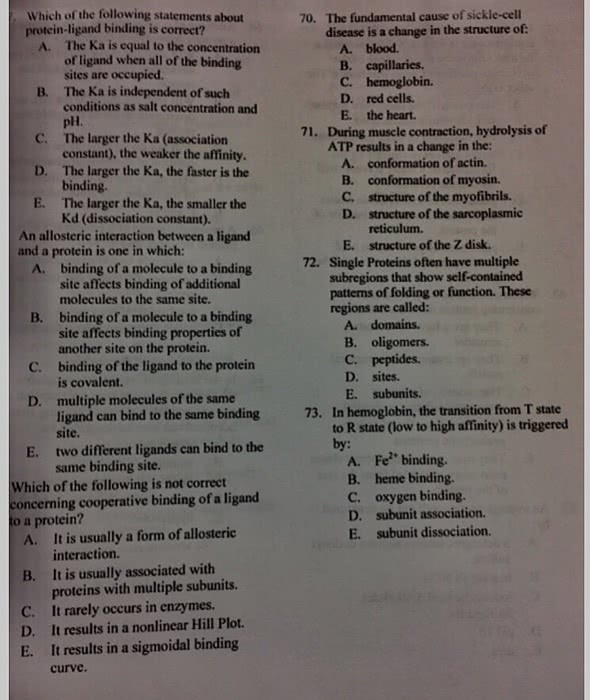BCHM 10000 Lecture Notes - Lecture 27: Myoglobin, Protein Aggregation, Hemoglobin

Hemoglobin
●Myoglobin facilitates diffusion of O2 in muscle tissue
– O2 solubility in aqueous solution limits respiration in active muscle tissue
– Myoglobin increases effective O2 solubility in muscle and promotes diffusion
from capillaries to mitochondria.
●Hemoglobin binds O2 in lungs and transports it to peripheral tissues.
●Myoglobin is a monomeric protein
●Myoglobin and the subunits of hemoglobin share a common “fold” (the globin fold) even
though their overall sequence identity is quite low
●The oxygen binding curves for myoglobin and hemoglobin are very different and
facilitate oxygen transport to muscles
●Hemoglobin exhibits cooperative oxygen binding (sigmoidal curve)
●Cooperativity comes about in a multimeric protein when the binding of one ligand
molecule increases the protein’s affinity for the binding of a second ligand molecule
●O2 binding alters electronic state of Fe(II) so that it can now fit within heme
●O2 binding moves proximal His and the F-helix that contains it
●O2 binding alters electronic state of Fe(II) so that it can now fit within heme
●O2 binding moves proximal His and the F-helix that contains it
●The F-helix tilts and moves across the heme plane
●O2 binding alters electronic state of Fe(II) so that it can now fit within heme
●O2 binding moves proximal His and the F-helix that contains it
●The F-helix tilts and moves across the heme plane
●F-helix movement induces changes at the α–β interface and ultimately the quaternary
structure of hemoglobin
●Conformational changes are reversed when oxygen dissociates in muscle
●Conformational changes in HbS upon oxygen unloading expose interaction sites for Val6
and lead to aggregations
●Conformational changes in HbS upon oxygen unloading expose interaction sites for Val6
and lead to aggregation
Document Summary
Myoglobin facilitates diffusion of o2 in muscle tissue. O2 solubility in aqueous solution limits respiration in active muscle tissue. Myoglobin increases effective o2 solubility in muscle and promotes diffusion from capillaries to mitochondria. Hemoglobin binds o2 in lungs and transports it to peripheral tissues. Myoglobin and the subunits of hemoglobin share a common fold (the globin fold) even though their overall sequence identity is quite low. The oxygen binding curves for myoglobin and hemoglobin are very different and facilitate oxygen transport to muscles. Hemoglobin exhibits cooperative oxygen binding (sigmoidal curve) Cooperativity comes about in a multimeric protein when the binding of one ligand molecule increases the protein"s affinity for the binding of a second ligand molecule. O2 binding alters electronic state of fe(ii) so that it can now fit within heme. O2 binding moves proximal his and the f-helix that contains it. The f-helix tilts and moves across the heme plane.


